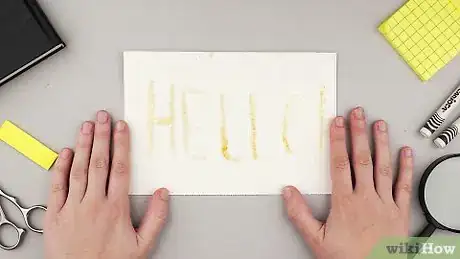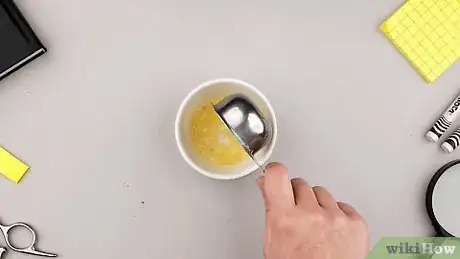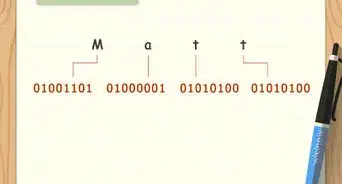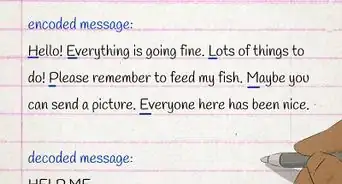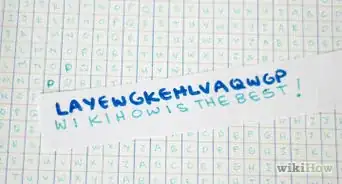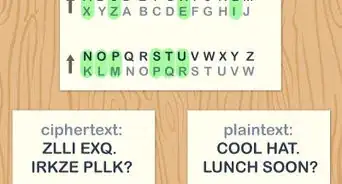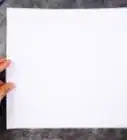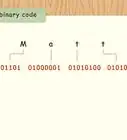This article was co-authored by wikiHow Staff. Our trained team of editors and researchers validate articles for accuracy and comprehensiveness. wikiHow's Content Management Team carefully monitors the work from our editorial staff to ensure that each article is backed by trusted research and meets our high quality standards.
The wikiHow Video Team also followed the article's instructions and verified that they work.
This article has been viewed 71,650 times.
Learn more...
Making invisible messages is something you can do just for entertainment or for a serious purpose. There are several ways to leave a message on a piece of paper so that it is invisible to the naked eye. Only a person who knows that there is a message, and knows how to reveal it, can read what you’ve written.
Steps
Writing with White Crayon
-
1Use white paper. If you use a colored piece of paper, the white crayon writing will be visible instantly. If you use regular white paper, you can write your message and it will be invisible against the white background. You can vary this method by using any color crayon with the same color paper, e.g. black crayon and black paper.[1]
- If you use other colors, make sure the crayon color and the paper color match exactly. For example, a dark orange crayon will not be completely invisible against a light orange paper.
- This method is just for fun and is most suitable for young children. Most adults could find this message simply by holding the paper at a different angle.
-
2Write your message exactly how you want it to appear. It might take a couple of tries to get your message right. You will not be able to see as you are writing, so the first few tries might be a little messy. If you need to get it right the first time, you could use a stencil to guide you as you write in your message.[2]Advertisement
-
3Have the recipient color over the message. Instruct the person receiving your message to color the paper with water soluble paint. As they apply the paint, the waxy layer of crayon will protect only the paper directly underneath it. This will result in your message standing out in white against the color of the paint around it.[3]
- You can also color lightly over the message with another colored crayon, but you have to be gentle not to displace the white crayon.
Writing with Sugars
-
1Mix a solution of water and sugar. Add one cup of sugar to one cup of hot water. This will allow the sugar to dissolve into the water. Let the mixture sit until it is cool enough not to burn the skin.
-
2Use a cotton swab to write your message. Dip the cotton into the sugar water and use it to write the message. You may need to dip several times depending on the length of your message. Try to avoid dripping or lingering with the cotton swab on the paper for too long. This will cause the paper to absorb more sugar water in that area and result in a large “spot” on the paper when you show your message.[4]
-
3Heat the paper. You can do this well with a toaster. Turn the toaster on and hold the paper overtop of the toaster. As the paper gets hot, the sugar will begin to caramelize and form long chains of sugar molecules. These chains absorb light differently than the smaller sugar molecules, and will have brownish color. This browning of the sugar reveals the message you wrote.[5]
- Do not put the paper in the toaster. It will start a fire.
- Children should have adult supervision when using this method.
Writing with Acids or Bases
-
1Choose an acid or base. Something dilute, such as vinegar (acid) or baking soda in water (base) is fine. Avoid using concentrated solutions. Wash your hands after handling an acid or base before touching your eyes or other sensitive areas.[6]
- Mix juice from half of a lemon with some water to make an acidic solution.[7]
- Mix a two table spoons of baking soda into a cup of water to make a basic solution.
-
2Write your message with a cotton swab. Dip the cotton swab into your acid or base solution, and proceed to write on the paper with it. After you finish your message, allow it to dry. Be sure to keep the rest of the paper clean of acid or base.
-
3Dab the paper with pH indicator solution. A pH indicator solution is a solution that changes color when it touches an acid or a base. You can buy these solutions from any chemical supply company, or make your own solution at home. One of the easiest pH indicators to make is a red cabbage solution.
- Alternatively, you can heat the paper and watch closely. The parts of the paper covered in acid or base will begin to brown slightly sooner than the rest of the paper.
- To make a red cabbage indicator solution, chop your cabbage finely and put it in a pot of water. Bring the water to a boil, and then turn the heat off. Let the solution cool and pour it through a strainer to remove the cabbage. The purple liquid remaining will be your indicator solution.[8]
Community Q&A
-
QuestionIs there a way to prevent seeing the message if looking at it from an angle?
 Community AnswerNo, I have tried it my mom has always seen it. But if you want it secret just whisper.
Community AnswerNo, I have tried it my mom has always seen it. But if you want it secret just whisper. -
QuestionWhere can I buy an invisible ink pen?
 Community AnswerYou can buy it in some children's stores or stationary shops. You can also order one online.
Community AnswerYou can buy it in some children's stores or stationary shops. You can also order one online. -
QuestionHow do I get a red cabbage?
 Community AnswerYou can buy it in the vegetable section of most grocery stores like Fred Meyer or QFC.
Community AnswerYou can buy it in the vegetable section of most grocery stores like Fred Meyer or QFC.
Warnings
- Be careful when handling acids or bases. Even dilute acids and bases can react vigorously with each other and irritate the skin and eyes.⧼thumbs_response⧽
Things You'll Need
Method 1:
- White Crayon
- White Paper
- Water Color Paint
- Paint Brush
Method 2:
- Water
- Sugar
- Cotton Swab
- White Paper
- Toaster
Method 3:
- Acid or Base Solution
- Cotton Swab
- White Paper
- Indicator Solution
References
- ↑ http://www.education.com/activity/article/magic-art-write-magic-messages/
- ↑ http://www.education.com/activity/article/magic-art-write-magic-messages/
- ↑ http://www.education.com/activity/article/magic-art-write-magic-messages/
- ↑ http://www.thenakedscientists.com/HTML/experiments/exp/invisible-inks/
- ↑ http://www.thenakedscientists.com/HTML/experiments/exp/invisible-inks/
- ↑ http://www.thenakedscientists.com/HTML/experiments/exp/invisible-inks/
- ↑ http://www.sciencekids.co.nz/experiments/invisibleink.html
- ↑ http://www.sciencekiddo.com/red-cabbage-ph-indicator/


